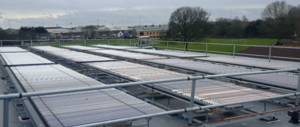Great Britain: Low Impact of RHI on Solar Thermal Market
May 11, 2012
Five months after the introduction of the Renewable Heating Incentive for commercial installations, the scheme’s effect on the solar thermal sector is almost zero. Of the 21 renewable heating systems approved by the end of April 2012, 16 are solid biomass boilers, 4 heat pump projects – and only one is a solar thermal system. The same imbalance can be found across all of the applications submitted to the RHI authorities. There are only 7 solar thermal projects among the 485 sent-in papers, the RHI helpline of Ofgem, UK’s electricity and gas regulator, confirmed at the beginning of May. Ofgem is in charge of paying the feed-in tariff to the owners of renewable heating systems. 80 % to 90 % of the submitted projects are based on biomass. The remaining projects all include a heat pump solution.
Source: Ofgem
According to Tony Staniforth, Specification Sales Director at Kingspan Hot Water Systems and Kingspan Renewables UK, “little or no public awareness and a not compelling enough tariff” are the main reasons for the small impact RHI has had on the solar market. Sharokh Sabba tends to agree: “The solar thermal market is still stagnating. There is only a slight movement. We are still selling much more photovoltaics,” confirms the Managing Director of Rayotec, a solar PV and solar thermal system provider.
The situation could change in the near future since the new solar electricity feed-in tariffs are cut in half since 1 April. Alan Aldridge, Managing Director of solar thermal system provider Riomay and newly elected chairman of the Solar Trade Association (STA), sees a good chance that solar thermal will get a second chance. “PV was completely dominant over the last two years, since the feed-in tariff was very lucrative. But now, PV is going down rapidly. A good chance to revive solar thermal, as 8.5 Sterling Cent are not unreasonable.”
But the support applies to commercial projects only. This is viewed as a great problem among several solar thermal providers in the UK, because they all focus on the residential market. There is great doubt that the announced residential part of the RHI will come into effect later this year. “The homeowner clients lost interest, because it took so long,” Chris Flaherty from solar thermal importer Genersys analyses. His team, on the other hand, seems to actively promote the RHI among commercial clients. “We have developed an Excel tool, which calculates the financial impact of the feed-in tariff for commercial clients, and our installers are using this tool,” explains Flaherty. They offer the heat meters from Swiss company Sontex, which are eligible for the RHI scheme. “Our sales increase rapidly,” Chris Bishop, Technical Sales Engineer at Sontex UK’s distributor, DMS Ltd, confirms. “All the Sontex meters are compliant with class 2 Annex MI-004 of the EU Measuring Instruments Directive, which is required by the RHI standard.” When asked why there is such a small number of solar thermal system applications for RHI, Bishop says that the technology has not been around long enough and payback times are still too long.
Kevin Carling, Managing Director from component supplier Secon Solar, another distributor of Sontex meters, confirms the increasing demand within the RHI scheme: “We have supplied about 40 or 50 RHI solar heat meters this year.” He adds: “The process for claiming RHI is very complex, so we are not sure how many solar thermal system owners with Sontex metres have successfully claimed RHI subsidies.” To make the process as easy as possible for system owners, the Secon Solar Manager hopes that there will be no metering for domestic RHI-funded solar systems.
More information:
http://www.seconsolar.com
http://www.dmsltd.com
http://www.riomay.com/
http://www.genersys-solar.com
http://www.kingspansolar.com
http://www.rayotec.com/


